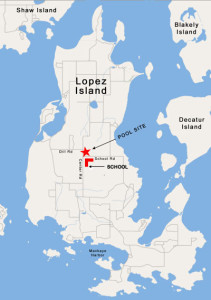by Claire Anderson | Oct 24, 2023 | News
Lopez Swim Center | Summary of Financial Projections, October 2023
Highlights
- A low-interest loan through OPALCO’s Switch It Up program will pay for heat pumps. A bridge loan/line of credit will be utilized for cash flow during construction to cover donor pledges and State commitments.
- Conservative revenue and expense projections target financial sustainability for the Lopez Swim Center by Year 3, with contingency planning built into the projections.
- A capital and maintenance reserve fund has been seeded with $510,000 (Year 1), grows to $775,000 (Year 10) and $1.89M by Year 20. These funds are earmarked for equipment repair / replacement and are funded from operations.
- A diversified income stream, including memberships and daily/weekly passes, swim lessons, camps, special events, and retail sales, will help ensure the Center’s financial sustainability.
- The Lopez Swim Center will draw upon four user markets, including full-time and part-time residents and their families and friends; residents of neighboring islands; and seasonal visitors.
- The majority of revenue (67%) will be generated by Memberships & Daily Use fees; 45% of this revenue is projected during summer months, when Lopez tourism peaks with 80,000 visitors over a 13-week period according to the SJC Tourism Bureau. Market penetration for full-time Lopezians obtaining annual memberships are conservative and includes discounted memberships between 50-90% for those needing financial assistance. Projections are that annual revenue generated from Lopez full-year and school-year memberships constitute only 37% of the gross income each year.



by Claire Anderson | Oct 3, 2023 | News
Pool Progress “Pool Progress: Behind the Scenes of the Lopez Swim Center” is an eight-part series to keep you informed with project updates, along with interviews from Swim Center experts, leaders, and community members supporting the campaign. This is part three of our eight-part series.
Meet Some of FLIP’s Pool Pros
In recent years, the expertise for the Lopez Swim Center’s planning, implementation, and operation has significantly expanded. Today, nearly 40 volunteers serve on six committees dedicated to project oversight, operations, fundraising, marketing, financing, and advising. Here, we highlight four of FLIP’s volunteer leaders—professionals in their respective fields who are contributing their skills and expertise to create the best swim center possible for the community.
Leading the Creative Charge 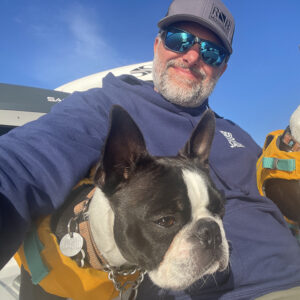
Executive Creative Director and partner of Graphiti, one of Seattle’s top digital creative agencies, Kevin Berger leads the firm’s creative vision and strategic direction. He works with national and global clients including Amazon, Munich Re, Colliers, and Nordstrom. He also has more than a decade of experience in board and volunteer facilitation from working with groups like AIGA, a national organization of design professionals. Graphiti led the rebranding campaign for San Juan Preservation Trust to achieve more inclusive participation in stewarding land conservation efforts. As a FLIP volunteer on the Marketing Committee, Kevin’s focus is creating a cohesive message and visual identity for the Swim Center.
FLIP: What marketing expertise have you and Graphiti brought to this project and how are you guiding the Swim Center’s branding and marketing?
KB: I’ve been able to tap into Graphiti’s broader team and donate some of our services to help support several aspects of FLIP’s marketing. Early on, we developed a communications plan that focused on generating excitement and awareness about the new pool. We also designed several renderings of the new pool to give the public an idea of the experience.
Another area where Graphiti’s team provided support was helping FLIP develop a video from ad agency creative writer (and Lopezian) Dave O’Hare’s written manifesto, which can be found on FLIP’s website. The manifesto grounds the project in a guiding vision; putting it on the website is a way for everyone to be able to see it and share in that vision.
FLIP: Are there any teasers you can share about the Swim Center’s branding effort?
KB: Yes! In collaboration with Dave, we’ve developed our “North Star” brand statement: “To surprise and delight everyone.” We’ll be doing that with opportunities that are inviting, fun, respectful, and, we hope, will generate a lot of enthusiasm. So, I’ll leave that to your imagination to envision where that might lead visually.
FLIP: Why did you join FLIP’s leadership? What most impresses or excites you personally about the project or the leadership?
KB: As a part-time Lopez resident (I’ve been a part of the community for more than a decade), I am invested in the island’s preservation and health. I want to see my community not only become a safer place with regards to water safety but want people of all ages to have a safe and healthy place to gather, exercise, and share new skills. I joined FLIP because I wanted to support a great group of longtime locals who were working towards these same goals. I knew my brand and marketing experience could really help, and I’ve never looked back. It’s been a very positive experience!
Monitoring Construction Efficiency & Cost 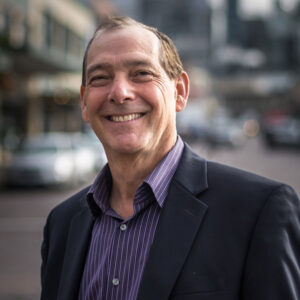
For 40 years, architect Eric Meng has led Studio Meng Strazzara’s design work, serving the Northwest’s leading public institutions, including K12 schools and universities, dozens of public pool facilities, and numerous recreational and performing arts facilities. He developed Meng Analysis, providing value engineering, constructability, facility condition, and performance analysis for major building and infrastructure projects worldwide. A past board member for the American Institute of Architects, he has served 30 years on Washington state’s construction advisory panel. He is a globally recognized leader for applying value management to design. Eric is a vital member of FLIP’s Project Committee, reviewing and providing essential feedback on the Swim Center’s design parameters and sustainability. As a highly respected architect, you bring expertise in value engineering, constructability, facility condition, and performance analysis.
Can you share what guidance you’ve provided as a FLIP Project Committee member?
EM: First, I’d like to point out that Kris Betty contributed a huge amount of expertise and energy leading the project committee as the project went through a long metamorphosis to get it to where it is today. The project has a competent design team, but ultimately, FLIP, as the owner, needs to make the decisions that ensure this project responds to community needs, and that it can be built within the tough budget parameters.
Since Bill LeDrew recruited me about two years ago to this committee, I have encouraged FLIP to seek some independent analysis to evaluate the project design, cost, and constructability. That has informed some desired changes and the selection of a very engaged contractor. The plan we are pursuing now is well balanced for cost, practicality, energy efficiency, and long-term sustainability. The constant challenge has been to balance the desire for a fully functional pool with the realities of the construction budget. My goal was to be sure that any cost-cutting measures would not have a detrimental impact on the pool’s long-term performance or maintenance. The most significant change was the pool cover structure, which in the end will result in a far more sustainable operation and provide an experience that takes advantage of the great Lopez summer weather.
What is most important for the community to know about the planning behind the Swim Center project? What gives you confidence in its design?
EM: Every detail of the project plan has gone through a long and arduous review and optimization. In addition to review by the project committee and the contractor, I hired a team of independent experts with whom I’ve worked professionally to conduct a constructability assessment. This thorough evaluation of the project’s design was very important to ensure there would be no delays from our end when the project was under permit review.
What was your motivation for joining FLIP’s project committee?
EM: When I was growing up, my parents were very active in getting a community pool in our local town of Normandy Park. As a result, I spent a good part of my free time as a teenager at the pool. This project is so important—especially for teens.
The Swim Center is going to be such a vital part of the Lopez community. What impresses me most about is the quality of the leadership and volunteer teams working on this project. They are experienced, professional, and genuinely interested in excellence for the facility as well as the organization. I have been part of a multitude of projects like this—mostly public and community—and the FLIP team of outstanding individuals and the way they work together outshines many.
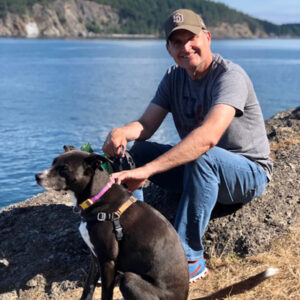 Pool Programming: Fitness & Fun
Pool Programming: Fitness & Fun
Matt Newman’s 30-year career in recreation and athletics includes extensive experience in aquatics operations. As the University of Washington’s director of recreation, he has helped lead planning design for the institution’s major pool and locker room renovation project, currently in progress. In prior positions, which called for creative programming for mixed-use pools, Matt excelled in striking a balance for all pool users at locations as diverse as The Evergreen State College and the Weyerhaeuser King County Aquatic Center. As a FLIP board member and on the Operations Committee, he lends his decades of experience to ensuring robust and responsive pool programming for the community.
As a new FLIP board member, what encourages you most about this project and its future operation?
MN: I’m impressed by the commitment of FLIP’s group of people—folks like Bill, Linda, Robin, Micki, and others—who’ve been at this a long time. They’ve never lost sight of the mission that we need a pool on Lopez. As we prepare for future operations, it’s been helpful to work with aquatic center consultant Stu Isaac on the sustainability model.
Our goal is to open and operate the pool and make it financially accessible for all. The fact that we will have a sustainable business model without having exorbitant membership fees is very impressive to me given how much the pool has to offer.
Describe how the Lopez Swim Center programming will compare to other aquatic centers where you have worked.
MN: At the University of Washington, we are completing a major renovation to expand and update the original pool, which was built in 1968. When the renovated pool opens, we’ll have 14 lanes for lap swimming, compared to the six lanes we have now, plus enough room to dedicate part of the pool to other activities during certain times of the day. At other aquatic facilities where I’ve worked, I faced the ongoing challenge of balancing demand for open swim, dedicated programming/classes, and lap swim. Instead of having more lanes, like UW added, the Lopez Swim Center will have two pools. It’s a game-changer.
First, we’ll be able to accommodate a lot more people. Second, from a programming standpoint, there’s much more flexibility for running different programs at the same time. We can even set the pools at different temperatures. This variable allows us to program our classes with a new level of specificity, such as warmer water for a rehabilitative class. With so much potential for programming, Lopez Swim Center can focus on its mission of teaching everybody to swim while offering a wide variety of additional water activities for health, fun, fitness, and more.
Talk about your passion for Lopez and how this project is part of that.
MN: I have been coming to Lopez for many years. From the beginning, it has felt like home. I’m from Nebraska, and Lopez has a similar feeling to me of where I grew up: It’s the people. Whether they are board members, committee members, folks in the community, or friends I’ve made over the years, Lopez people care deeply about this community. That’s what I am drawn to. It’s why I get more engaged with Lopez every year. The chance to bring my expertise to this project and become a FLIP board member have been the perfect opportunities for me to contribute to the community. It has been very fulfilling, and it is just the beginning for me. Lopez has felt like home for years, and now I’m working toward making it my home.
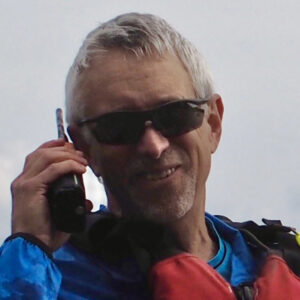
Keeping an Eye on Efficiency
Brian Silverstein brings four decades of experience in the electric utility industry and has served on the board of the local utility cooperative, OPALCO, since 2016. He retired in 2012 as senior vice president of transmission at the Bonneville Power Administration (BPA), a federal utility that provides energy to Northwest consumer-owned utilities. At BPA, he enabled connecting enough wind generation to power more than 500,000 homes. A full-time Lopezian, he collaborates with FLIP as a trusted energy-efficiency advisor for the Swim Center.
With decades of leadership experience in the electrical utility industry, including your current service as a board member of OPALCO, what’s been your role in connecting the Swim Center project to the utility’s low-interest loan program for heat pumps? How will those pumps contribute to energy savings for the Swim Center?
BS: The lowest cost and cleanest way to use energy is to be efficient. The challenge is that not everyone can make an investment even if the payback is fast. The USDA Rural Utility Service is one of OPALCO’s lenders. They offered to fund a program for energy efficiency. OPALCO jumped on it, naming it Switch it Up! It started with residential members and is now available to all members, including nonprofits and businesses. FLIP can apply, like any other member, for a low-interest loan to fund the Swim Center’s energy-saving equipment. It is projected that using electric heat pumps instead of propane-powered ones to heat the two pools, shower house, and dome, will save $440,000 in energy bills over 10 years. Equally important, using electric heat pumps would avoid putting out 750 tons of carbon dioxide a year.
Having served as an advisor for seven years on FLIP’s leadership team, what changes have you seen over the years in the project’s management?
BS: FLIP leadership started with swimming advocates, some of whom had experience with swimming pool operation, finance, communications, and construction. During the time I’ve been involved, the leadership team has brought in more special knowledge, including people to reach out to all the parts of our community who would use the pool.
What is the most inspiring aspect about the Swim Center project or its leadership?
BS: My wife was one who encouraged me to get engaged with the project. After we moved to Lopez, she was one of the volunteers who took elementary-school students to the Anacortes pool for Swim Days, which were sponsored in part by FLIP. She was shocked at how few students had basic water skills.
So besides creating a space where people can learn and practice essential swimming skills, there are two things I’m focused on—getting the pool built and having a facility that is cost-effective and energy efficient. Personally, I’m looking forward to learning to roll a kayak and practicing my water-rescue skills.
This article series is supported by a grant from the Lopez Thrift Shop.
by Claire Anderson | Sep 12, 2023 | News
“Pool Progress: Behind the Scenes of the Lopez Swim Center” is an eight-part series to keep you informed with project updates, along with interviews from Swim Center experts, leaders, and community members supporting the campaign. This is part two of our eight-part series.
Project Updates
Financial Assistance Program. Ensuring the entire Lopez community can access the Swim Center is essential. We are a diverse community with vastly different financial resources, so financial assistance will be available for those individuals and families in need, with significant (50% to 75%+) discounts off standard membership rates.
Lifeguard recruitment! You’ve heard about the lifeguard shortage affecting pools nationwide. We have taken steps to ensure the Swim Center has the lifesaving staff we need. This June, the Swim Center launched lifeguard information sessions and continues to receive sign-ups. Please contact info@lopezislandpool.org if you are interested in becoming a lifeguard or swim instructor.
Discussing Domes, Dollars & Permits
FLIP’s Board Chair Bill LeDrew and Executive Director Anne Marie MacPherson answer questions about the new pools’ progress.
Q: There hasn’t been much news about the Lopez Swim Center this past year—why?
AM: While there’s not been much public news about the Swim Center, the board, staff, project team, and committees have been working diligently behind the scenes to create an even more efficient Swim Center, both in design and operation. It’s been a focused and productive time during which we’ve been laying the foundation for a well-run and financially sustainable swim center. We are excited to share our progress: Join our Town Hall on September 22.
Q: What is happening with project costs? How are you keeping this project attainable?
A: Inflation and other economic drivers over the past two years have contributed to cost escalation affecting this project. In late 2021, our general contractor provided an updated cost estimate that led us to simplify and downsize the facility to reduce costs and ensure that the project remained affordable. We scaled back the showerhouse design and identified more energy-efficient equipment choices. The biggest change was to transition from a natatorium with a retractable roof to a seasonally indoor/outdoor pool with an air-inflated dome.
Q: I keep hearing about the dome. How will it work?
A: An air-inflated dome, or “bubble,” will cover the pools during the cooler months and allow indoor swimming. In warmer weather, the dome will be deflated to allow open-air swimming. We choose Arizon because, first and foremost, it is an air-handling company, specializing in air quality and air flow. The Arizon dome is durable and long-lasting: Arizon’s air-handling system is designed for a 30+ year lifespan, and the fabric is designed for a 20- to 30-year life, with a 20-year warranty. A wind/snow sensor will automatically adjust air flow and a backup generator will kick on in the event of power failure. The dome has a translucent skylight that will allow natural daylight during the day and reduce the need for artificial lighting. Domes are relatively simple to put up and take down. The membrane folds up and can be stored on two large pallets during the warmer months. For more information, view Arizon’s aquatics brochure.
We spent months researching and interviewing facilities that use domes in various climates and locations; all dome users reported being extremely satisfied with the domes’ performance and durability. Three swim clubs on nearby Mercer Island use domes over their pools!
Q: Does the project have all its permits?
A: We are still waiting for our final permits. As you may have heard, the San Juan County Building Department has been overburdened due to staffing and technology challenges. This has resulted in delays in receiving our building permits. The good news is San Juan County Building Department has outsourced our permit application to help expedite the approval process. The review is proceeding, and no concerns have been raised. We have done everything possible to ensure a smooth review on our end.
Q: In what ways is the Lopez Swim Center stronger than ever?
A: We have been using this time to focus on implementation and operations. When the pool opens, we’ll be in great shape to run the Swim Center! Our highly detailed financial projections are based on aquatic trends and facilities with similar communities and programming. We have planned a sustainable operation that will meet the community’s needs for years decades to come.
The Lopez Swim Center has scaled up its leadership with knowledgeable professionals who are guiding the planning, fundraising, construction, and future operations of the Swim Center. Our leadership team has grown exponentially to include volunteer committee members with expertise in key areas (see an upcoming article for interviews with a few of our committee members.)
In addition, we hired nationally renowned aquatic experts Water Technologies Inc. (see WTI article here) to oversee the technical design of the pool and recommend the most effective and efficient equipment. They advised us on the best choices for operating cost, energy, and water efficiency for maintaining a pool on a remote island. For example, although a saltwater pool was initially planned, WTI has counseled that the staffing expertise and maintenance implications of operating saltwater pools wouldn’t be appropriate for our island location.
We are ready to begin construction once the permits are approved and the appropriate funding is in hand. With construction-ready drawings finalized, our general contractor Chad Fisher Construction has lined up the necessary subcontractors for the job.
Q: What is the budget for the project? How much has been raised?
A: We won’t know the final cost of the pool until the permit is approved. We know that costs continue to rise and, despite our budget cuts, there will still be a financial gap. But we are confident that once we receive permits, we’ll be able to close the gap. So far, more than $7 million has been raised from 1,100 donors. Our amazing community has shown how much they want this swim center!
We’re building something on this island that will last for generations. We hope the community will be inspired to join us in this fundraising homestretch. It takes a while to create something great, but it will be worth the wait.
More than just a pool: We are a place for wellness, safety, and fitness, and an all-ages gathering place for the community.
This article series is supported by a grant from the Lopez Thrift Shop.
by Claire Anderson | Aug 31, 2023 | News
Pool Progress: Behind the Scenes of the Lopez Swim Center
FLIP Speaks with Water Technology Inc.’s Ryan Nachreiner
The campaign to build the Lopez Swim Center has retooled and is better than ever after project delays last year that were beyond our control. This eight-part series will provide you with project updates, along with interviews from aquatic experts, leaders, and community members behind the campaign. This is part one of our eight-part series.
PROJECT UPDATES
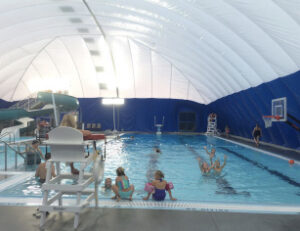
Cost savings—Project leaders made the following planning decisions to reduce project costs without sacrificing quality:
- Simplified design of the shower house
- Selected energy-efficient equipment for lower operating costs and durability
- Became a seasonal indoor/outdoor pool (instead of an indoor pool with a retractable roof) to save both costs and energy. A heated, air-inflated dome will go up in fall for indoor swimming in cooler months. In late spring, the dome will be deflated and stored, for open-air swimming. Left, above: In cold weather, an air-inflated Arizon dome will provide a warm space to enjoy both pools. During the summer, the dome will be removed for open-air swimming.
Timeline—We hope to open the Swim Center in late 2024. Please understand that in our post-COVID world, construction projects remain vulnerable to staffing, cost escalation/funding, and supply-chain issues that could impact this timeline. We are also waiting for the San Juan County permit (see more details in our next article).
Lopez Swim Center Talks with Water Technology Inc.’s Ryan Nachreiner, Regional Director of Project Development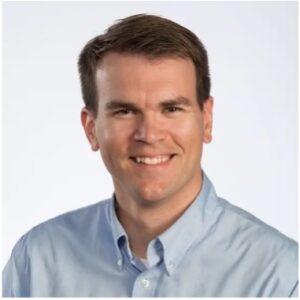
LSC: What is Water Technology Inc.’s role with the Lopez Swim Center project?
WTI: Water Technology Inc. (WTI) is a specialized design firm focused solely on aquatic recreation. For the Lopez Swim Center, we prepared the design and engineering drawings and the specifications for the mechanical and water-treatment systems. These designs are crucial to obtain permit approvals, to bid contract work, and to guide the facility’s construction.
LSC: What is WTI’s experience in the Pacific Northwest and with local regulators?
WTI: WTI has been working in the Pacific Northwest, and Washington state in particular, for over 25 years. As the largest and most experienced aquatic design team in North America, we take a personalized approach to each region where we operate. In the Puget Sound and Salish Sea area, we’ve built a long history and strong relationships with local regulations and code officials.
I live in Bellingham and make a point of being involved in issues affecting our industry at the regional level. I serve on a Department of Health advisory board that is responsible for revisions to state pool codes. WTI also works across the country and in Europe, Asia, and the Middle East developing destination waterparks and family aquatic centers. This experience gives us access to the latest trends and technologies across five continents. No other aquatic firm brings our extensive experience in the Puget Sound and Salish Sea area and the industry knowledge, resources, and technologies from our work around the world.
LSC: Can you talk about some of the equipment that Lopez Swim Center has selected for the new pool?
WTI: Good choices of materials and equipment are crucial for the long-term operation of the facility, especially considering the remoteness of and streamlined staffing operation needs of this facility. Each of the major mechanical components—pumps, filters, controllers, and disinfection systems—are being provided by established companies with highly refined product lines. Equipment was selected for its durability and serviceability. The pools will be constructed using preconstructed steel panels made by Myrtha Pools, a company known for having one of highest quality methods for pool construction with a 25-year warranty. The choice of steel Myrtha pools eliminates the need to for draining them every 3 to 7 years like traditional pools, saving significant water consumption as well as operating costs. With these quality products, the Lopez Swim Center will be able to have manufacturer support over the facility’s lifespan.
LSC: Pools are known to be energy hogs. How are you addressing cost and conservation?
WTI: Pools are energy users, but the Lopez Swim Center has made decisions that significantly reduce its energy consumption. For the Swim Center, we tackled waste and inefficiency in three areas: water and space heating; water filtration; and water circulation / pumping. The most important investment is that the Center will operate with heat pumps powered by electricity. The net result is a 75% reduction in annual operating costs and eliminating the use of 48,000 gallons of propane annually. Secondly, we’ll use advanced filtration with regenerative media filters, which uses up to 90% less water than more common filtration systems, and at the same time, does a better job filtering particles out of the water. This matters because the less water a pool uses, the less energy that’s needed to heat that water.
The largest energy users in pools typically are the pumps that continuously circulate water through the filtration and water treatment system. For efficiency, we’ll have a variable frequency drive on every pump motor directing it to run at precisely the power it needs and preventing wasted energy.
LSC: How does the pool’s design support a positive swimming experience?
WTI: The Lopez Swim Center will offer a broad range of programming for pool users of all ages. There are children learning to swim and retirees keeping healthy and fit, plus a range of swimmers between. To best serve the different pool users and the different types of programming, we designed two separate pools that can be kept at two different temperatures. This allows, for example, the Lopez Swim Center to host water exercise classes in one pool with warmer water to benefit joints and muscles, while keeping another pool at a lower temperature that’s more suitable for lap swimming or swimming lessons. Of course, safe and sanitary water is essential to a positive swimming experience. Advanced filtration and automated UV disinfection systems will continuously provide exceptional water quality; a supplemental sanitation system will provide extra protection against pathogens in addition to the primary disinfection system.
To learn more about the campaign for the Lopez Swim Center contact:
Anne Marie MacPherson, Executive Director Friends of Lopez Island Pool, at director@lopezislandpool.org
This article series is supported by a grant from the Lopez Thrift Shop.
by Claire Anderson | Apr 3, 2023 | News
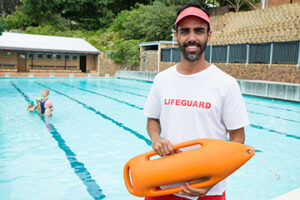
Having well-trained lifeguards will be a crucial element in the Lopez Swim Center’s successful operation, and FLIP is getting a jump-start on lifeguard recruitment and training with Lopezians Paul Henriksen and Kathryn Tucker. These community movers and shakers are helping launch this vitally important program for the Swim Center.
FLIP: What motivated your decision to join FLIP’s efforts to build a Swim Center on Lopez Island?
Paul Henriksen (PH): I love to swim and I feel very strongly that every child should learn to swim. Swimming is a life skill. We have lost a few people in Hummel Lake since I moved here in the late ’70s.
Kathryn Tucker (KT): I spend more time on Lopez now and love to do what I can to serve the community. I think the pool will be a hub of community and I hope to be part of making it a great success.
FLIP: What are your main reasons for spearheading the Lifeguard Training Program?
PH: I want to ensure that our pool has good lifeguard coverage so we can all swim safely. And that dovetails into children being able to learn this essential life skill.
KT: As a lifeguard for many years when I was younger, I know what is involved (although now I have greater awareness of the great responsibility vested in lifeguards). I am eager to see the pool open and become a thriving community hub on the island, offering a new way for maintaining and nurturing fitness.
FLIP: As the leads for the Lifeguard Training Program, tell us what the mission is, and what the near-term goals are.
PH: We want to have enough experienced, certified lifeguards when the pool opens and also encourage Lopez youth to the possibilities of becoming lifeguards and serving this community.
KT: Our current goal is to encourage interest in lifeguard candidates and help them understand what is involved in gaining certification: the commitment of time and effort, and necessary physical fitness to succeed.
Because lifeguards have much more limited training and will always call 911 for EMS in any significant medical emergency, the pool lifeguards will need to interface with Lopez EMS. Beginning discussions with EMS will be among the next steps.
FLIP: The spring 2023 fundraiser is focused on obtaining life-saving equipment, but clearly the pool will need people who are trained to use this equipment. What have been your recruitment efforts thus far?
PH: We currently have a list and contact information for people who have expressed an interest in lifeguard training on Lopez. We hope to draw from that group, and will stay in touch as the pool and program develop.
We are eager to hear from anyone who has the motivation to become a lifeguard and help to staff the new pool. For more information or to get involved, please email info@lopezislandpool.org or sign up via FLIP’s volunteer portal at https://www.lopezislandpool.org/volunteer.
KT: Prospective lifeguards include competent swimmers with a strong physical fitness base who are interested in learning how to rescue swimmers in distress or drowning, and providing first-responder care to pool visitors who have a medical emergency out of the water, in or around the pool facility. Candidates could be high school juniors and seniors, Lopez Fire and EMS first responders, and just about anyone else who has the requisite interest and abilities.
FLIP: When the Lopez Swim Center is complete, who will be leading those trainings?
KT: The choices include prospective lifeguards going to the mainland for training; bringing a lifeguard trainer to do training at the Swim Center; and certifying one of the Swim Center’s lifeguards as a lifeguard instructor to offer training here.
FLIP: It seems like most people have pivotal swimming experiences that shaped their interaction around and in the water. What were yours?
KT: My dad taught me to swim at a very young age in Long Island Sound, off the beach in Clinton, Connecticut. Later, I swam on my high school swim team and became a certified lifeguard. I worked then and in college as a lifeguard.
I had plenty of opportunity to use my life-saving swimming skills when I started whitewater kayaking in college. I competed in whitewater slalom kayaking races and was a member of the U.S. Kayak team in some international competitions. I also paddled Olympic Flatwater kayak, and in 1984 was U.S National Champion in K2 Women’s and K2 Mixed (with fellow Lopez paddler David Halpern, who was on the Olympic team that year).
PH: I learned to swim at a very early age, I was probably 6 or 7 years old, in the Seattle area. Through high school, in the summer, I continued to swim daily in Lake Washington,
I received my first lifeguard training certificate via WSU in the late ’60s; I became SCUBA certified in the mid ’70s. In the mid ’80s, I rescued a swimmer who passed out in the shallow end of a pool. He was demonstrating how long he could hold his breath underwater (after returning from doing some free diving in Australia). It was an easy rescue because the water was only about 3 feet deep. In the early ’90s, I helped to keep a swimmer afloat in large waves off the Big Island of Hawai’i until lifeguards arrived on paddle boards. In the early 2000s, on a school field trip, I kept a student from drowning in a lake.
FLIP: Please share with our readers how you found Lopez—or how Lopez found you.
PH: I grew up in Seattle, just down the road from the Carpenters. They owned the Lopez Village Market, so I heard about Lopez frequently. During the summer of ’78, I came to Lopez on weekends to help build a cabin on Shoal Bay for the McArdle family. I visited Camp Nor’wester and was extremely impressed with that site and operation. A position was advertised in late summer for maintenance supervisor and caretaker for the camp. I applied, got the job, and moved to Lopez full time in November 1978. I met my wife, Christa Campbell, here in the early ’80s. In 1989, shortly after our first child was born, we were offered the position of directing the camp. The Camp had a large waterfront program and a saltwater swimming pool, so we needed lifeguards. In the spirit of not asking our staff to do anything we wouldn’t do, I kept up my certification by going to Friday Harbor and Bellingham (and even to Canoe Island one time), for recertification.
KT: I got to know Lopez through the Halpern family. David Halpern was a kayak teammate; that family owns a lovely piece of inland property on Lopez Hill. My then-husband (Scott Tucker) and I bought the adjacent undeveloped and remote 10 acres at the very top of Lopez Hill in 1991. Both of our kids, Torin and Montana, grew up spending a lot of time here, including in LIFRC summer camps, sailing, soccer, and horseback riding. We built our off-grid cabin ourselves. Our other neighbor is the Lopez Hill Forest Preserve, where I am often out on the trails. I love hiking, biking, trail running, cross-country skiing, and kayaking.
My day job is as a lawyer engaging advocacy to protect and expand the rights of the terminally ill. I am a long-time yoga practitioner and teacher. I blend my day job and my yoga teaching in offering workshops called “Preparing for the Final Asana: Law and Medicine at the End of Life and What Yoga has to Offer” at retreat centers, including Kripalu in western Massachusetts. In the summers, I lead Saturday morning yoga practice on the deck at the Islander.
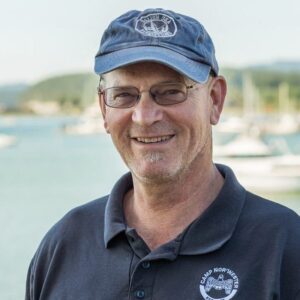
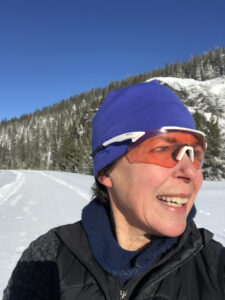
Above: FLIP’s Lifeguard recruitment leaders Paul Henriksen (L) and Kathryn Tucker (R).
____________________________________________________________________
FLIP is thankful for Paul and Kathryn’s leadership in launching the Lopez Swim Center’s essential lifeguard recruitment and training program. For more information or to get involved, please email info@lopezislandpool.org or sign up via FLIP’s volunteer portal at lopezislandpool.org/volunteer.
FLIP’s mission is to bring greater health, water safety, and community to the people of San Juan County by building and operating a sustainable, low-maintenance, indoor/outdoor Swim Center that will serve the community for generations to come. Our vision is to have a safe place for our children to learn to swim; for all ages to have an accessible pool for recreation, socialization, exercise, and water therapy; and to foster a healthier and more connected island community. This spring’s GiveLopez and GiveBIG fundraiser focuses on raising money to purchase necessary lifesaving and accessibility equipment. Give online at https://www.wagives.org/story/Fliplifesavingequipment/
This series of informational interviews with pool experts and articles on pool progress was made possible by a generous grant from the Lopez Thrift Shop. We greatly appreciate their support in helping spread the word about the Lopez Swim Center!
by Lisa DiGiorgio | Oct 19, 2020 | News
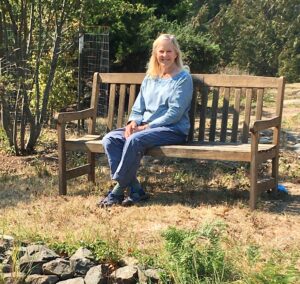
We are thrilled to share that Lopezian Inez Black has pledged $100,000 toward our Lopez Community Swim Center !
For more than five years, Inez Black has been a consistent and interested supporter of Friends of Lopez Island Pool (FLIP). Like many, she’s been concerned about the sustainability of the facility and its accessibility to all. This year, after learning that one donor had pledged $500,000 for a Maintenance Reserve Fund and another donor pledged $100,000 for the Swim Center’s Scholarship Fund, she felt motivated to become a leadership donor.
At a September FLIP “Poolside” presentation, Inez expressed her concerns that only 8% of Lopez children are water competent (American Red Cross 2017 assessment of 110 Lopez Elementary School students). She added that “unfortunately, proximity to the water does not necessarily mean one will know how to swim and feel safe in and around the water.”
Inez feels fortunate to have learned to swim at an early age, on the East coast, at her home on the Tred Avon River on the Eastern Shore of Maryland. Her father taught her to swim before age five, in a small pool he built in the river; then she continued lessons in the family pool, and later at a camp on Lake Champlain. As she became comfortable and confident in the water, she also enjoyed fun times in the water with friends. These positive experiences led Inez to other sports, including sailing and canoeing.
Her late husband, David, grew up in the Northwest, on Bainbridge Island. He learned to swim in a community saltwater pool on the shores of Puget Sound. He enjoyed sailing in his family’s Senior Blanchard Knockabout and, as a young adult, led his own mobile camp for boys, “The Vagabonds,” which included several weeks sailing in the Salish Sea among the San Juan Islands and up to Desolation Sound.
Living on Lopez 50 years ago, there were few options for swim lessons. Inez recalled, “Two private pools: Camp Nor’Wester’s pool was available for just a few hours and at the Lopez Islander Resort, where Marian Speidel taught swimming.” Inez emphasized, “Now, 50 years later, we really need a community facility to provide a safe place for all to learn to swim and develop water safety skills.”
Inez shared, “Our early positive experiences in and around the water led to many years together enjoying the Salish Sea. I feel everyone deserves the same opportunity we had, so I decided to act.”
When Inez was asked why she decided to give at this time, she shared, “It feels like the project is on a strong footing after years of diligent research and thorough planning by a dedicated local board. I hope others will ‘jump in’ to help take this important project to its next step. What a great opportunity for cross-generational community to learn swimming and water safety together—a life-saving legacy!”
Thank you, Inez, for helping to bring us that much closer to making the Lopez Island Swim Center a reality!
Lopez Will Swim!
Philip Prud’homme, Executive Director, and the FLIP Board













